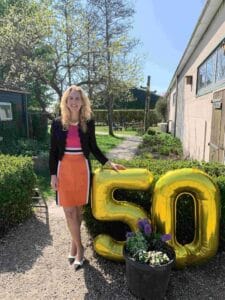Now that we were at the top of Croatia (region Istria), it is relatively short distance to sail to Venice: 60 nautical miles. With an average speed of our boat of 5 nautical miles per hour, we could do this in 12 hours.

And that was exactly our plan and what we did (see the map above)! Because we had been tipped a few times, not to sail up from the heel of Italy along the east coast (e.g. Rimini) to Venice, but to do so via the Croatian coast: much more beautiful nature and cleaner water. The east coast of Italy is said to be quite bare and industrial (high-rise buildings) and the water is said to be unclear. So we followed the advice to sail north via Croatia and that’s how we ended up in Venice with our sailboat😉.
Prepare yourself before sailing into Venice!
You can see us sailing into Venice in the photo below, but that required a lot preparation, because you don’t just ‘get’ into Venice. We have a Mediterranean Almanac (also called a ‘pilot’), which describes all areas regarding currents, depth, dangerous rocks, government regulations, etc. Below you can see the map with guidelines for Venice, it indicates:

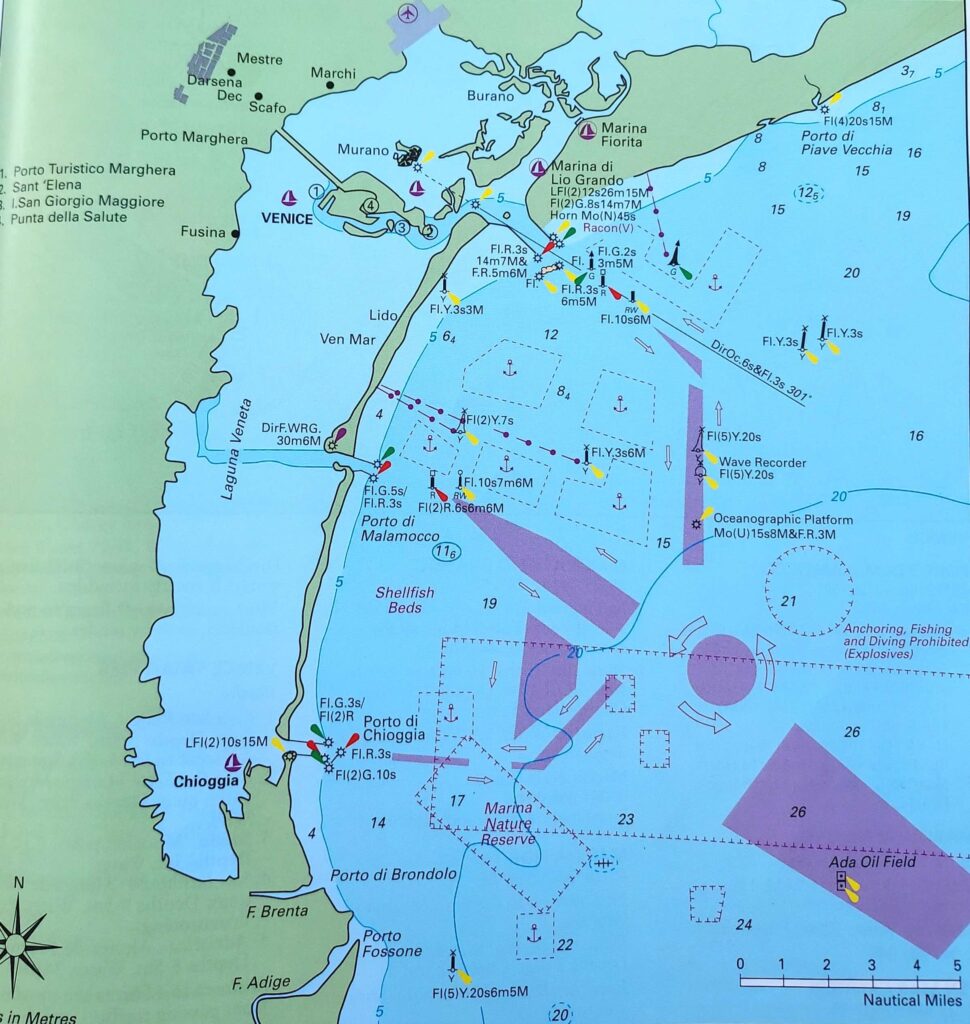
– There are 3 entrances to the Laguna Veneta: which entrance is good for private sailing yachts?
– There is an oil field (bottom right), a Marina Nature Reserve (bottom left), shellfish beds (middle), etc
– There is (circle in purple) a kind of ‘roundabout’ for ships that regulates the incoming and outgoing ship traffic (never seen before!)
– There are (in purple) directions for the shipping channel and also an oceanic platform and wave recorder (middle)
– There are indicated anchorages and also many places where anchoring, fishing and diving are prohibited
– The description in the almanac states that you must report to Marifoon Channel 16 (that is the Venice Yacht Pier) when you enter Venice
– Once in the lagoon, you really have to use the shipping lane at all times (indicated by wooden poles), because there are many shallows, from 1 meter to only 50 cm deep. And hoisting your sails is prohibited, only motor sailing in this area
– We understand very well that sailing is prohibited, because it is an anthill of speedboats, sailing yachts, water buses (vaporetti), water taxi’s, gondolas, cruise ships, etc. You need eyes everywhere to move around on the waters of Venice
– In the Grand Canal (the main waterway) it is not appreciated if you go there as a non-resident with your tender (‘it is off-limits’). And you should not want to do it also, motoring through the narrow canals with a lot of fast-moving destination traffic, which causes a lot of waves between the houses in the canals
Ok, lots of rules and obstacles. But once we had overcome all that and sailed into Venice, it was great to see the San Marco square from the water and from your own sailboat! We made a video of our first impressions on our first entry:
It is indeed hectic with all the boat movements on the water, but the view of the beautiful floating city with the impressive buildings from the Baroque and Renaissance period makes up for a lot! And you can get much closer to the building than I thought with your private sailboat.


My favorite 10 facts about Venice:
1. Venice was founded in the 5th century AD by inhabitants of the mainland who sought protection against invasions by the Germans
2. The city is built on an archipelago of 118 small islands, which are connected by approximately 400 bridges
3. 50,000 people live in the historic city center of Venice, and 20-30 million visitors come every year
4. Venice is slowly sinking, about 2-5 millimeter per year. So the city has built a series of mobile dams that lie underwater outside the lagoon and are filled with air at high tide to protect the 3 entrances from the high water that then no longer flows into Venice
5. Venice has approximately 150 canals, of which the Canal Grande is the most important. This canal, which splits the city in two, is approximately 3.8 kilometers long and has the shape of an inverted “S”.
6. There used to be thousands of gondolas, today there are about 400, mainly for tourist cruises. Each gondola is handmade and measures exactly 11 meters, with an asymmetrical shape so that they can be easily steered with a single oar. Becoming a gondolier is not easy; you have to pass an intensive training and exam to get a license. It was only in 2010 that the first female gondolier in 900 years was registered.
7. No cars allowed in the historic center of Venice: by boat or on foot is the only way to get around. So we also saw a DHL boat, an ambulance boat and a police boat.
8. The most famous bridge is the Rialto Bridge, which was completed in 1591. Another iconic bridge is the Bridge of Sighs (‘Ponte dei Sospiri’), which connects the courthouse to the prison. Prisoners used to walk across this bridge, giving them a last glimpse of the outside world before being locked up.
9. The Carnival of Venice is world famous. The wearing of masks during Carnival dates back to the 13th century and was originally intended to hide the social status of the wearer, making everyone equal during Carnival.
10. A unique bookstore in Venice: the books are displayed in a special way, namely in bathtubs, boats and other watertight containers. All this is intended to protect them from the frequent flooding in the city.
Venice by night
Because anchoring is difficult in the shallow lagoon and this was our first introduction to Venice with our sailboat, we had reserved a harbor for the first night to be on the safe side. That way we could also visit the historic city center of Venice by water taxi. First we visited down town historic Venice in the evening, which is very mysterious to walk through the narrow streets and along the dark water:


And how great it is to see the restaurants close to the water, we also found a cozy restaurant ourselves along a canal, with excellent food.


Venice by daylight
Venice is also beautiful to walk through during the day: every time a different island. You cross a small bridge and you see different houses, shops and restaurants.


And of course these are the classic photos you must have taken: at the gondolas in the canals 😊


And here on the famous Rialto bridge:


But let’s be honest, the 20-30 million visitors a year means every day crowded in the city in high season (July/August), because these are also photos we took:


And romantically sailing through the canals in a gondola? Get in line! Literally. Because you are certainly not ‘oh solo mio’.


My friend, Susan, who joined us for a few days visiting Venice, also mentioned how busy it was. It was not possible to get a picture of us alone on a bridge in the middle of Venice.

Still, you can find plenty of quiet streets if you go a little outside the streets on the Grand Canal, just wander 4 streets and you will come across this:


In short, with a bit of common sense (and GoogleMaps) you can also visit the quiet still gorgeous places.
Ssshhht: it was forbidden, but we motored into the Grand Canal with our tender
Yes, I know, it was off-limits, you are not allowed to sail through the Grand Canal with your tender as a non-resident. But hey, we are Dutch, to us ‘no’ means maybe there is a possibility. And we only have this chance now that we are here with our sailboat and tender. So we just did it, here we go:
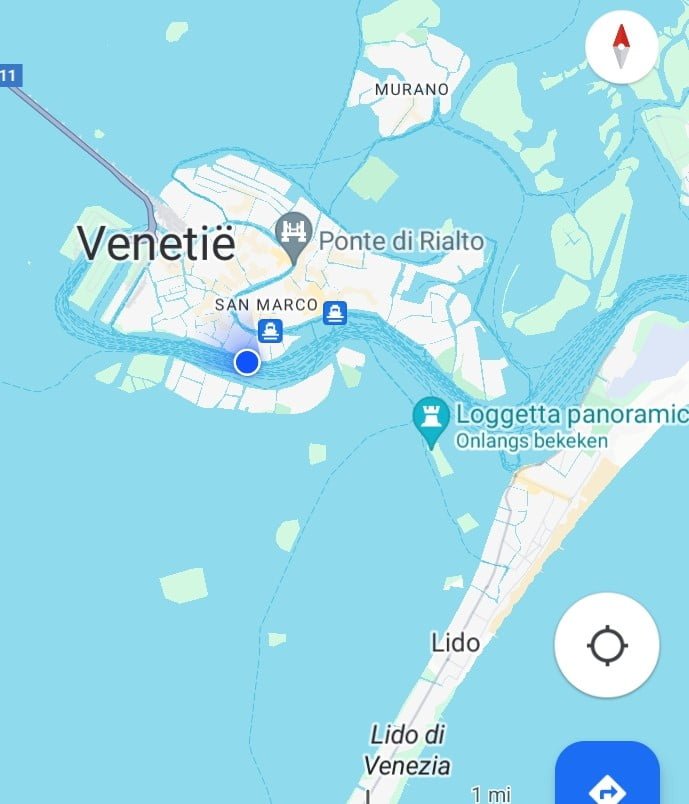

And it was great, also a bit tricky through the narrow canals with a lot of waves and 10,000 other boats, check out our video of the trip in the small canals:
We were called crazy about 5 times by Italians in taxi boats or gondolas (swearing at us in Italian is intense with all the hand gestures….). We were clearly tourists, but Gilles kept moving along with the fast-moving traffic. We enjoyed how you could almost touch the houses and saw everyone in the city doing their thing (loading fruit into the boat, transporting guests).


And here we are sailing out of the Grand Canal again, towards our sailboat, also a bit relieved 😉.

Venetian surroundings: 3 other great places in the Laguna Veneta
As I wrote, Venice is made up of 118 islands that were located together in the lagoon, but there are 166 islands in total in the laguna veneta. So there are a number of other islands around Venice that are worth visiting.
Burano
A surprisingly nice island north of Venice, which is still an active fishing village and where lace is made by hand. But the island is especially popular because it looks charming with its colored houses (so that the fishermen could easily find their way back in the twilight, so the rumor goes).


We walked over the island and photographed these nice places:


San Servolo
When we had delved further into the area of Venice and spotted a few good spots for our boat with our own eyes, we sailed to this island. On the west side there were 2 jetties that were fine for boats up to 1 meter deep to moor. Free.


San Servolo was a former psychiatric hospital, but is now a conference center. We were able to walk freely over the island.
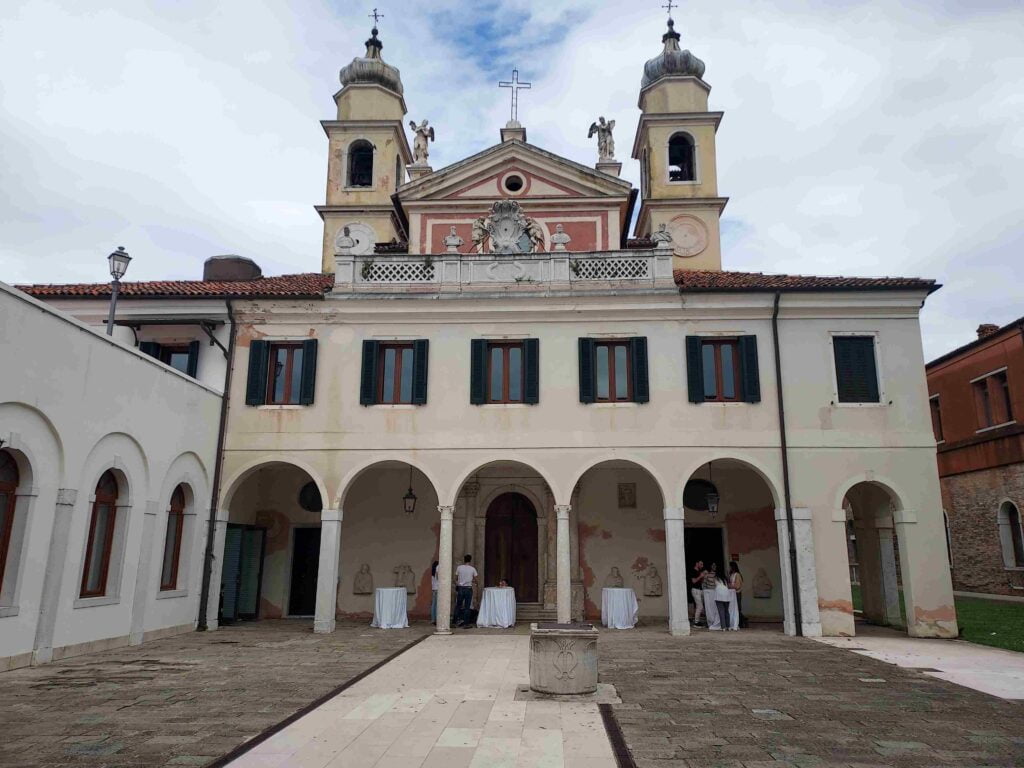

From the island we had a great view of the south side of Venice, including San Marco square. We therefore let our drone fly from the catamaran docked at San Servolo, to the San Marco square, so this is what Venice looks like ‘by air’:
Poveglia
We slowly headed towards the middle exit of the Venetian lagoon to check out again. We decided to enjoy this beautiful lagoon for another day, and anchored here at the island of Poveglia. It turned out that there was an enormous history surrounding it and, as befits Italians, also thickly exaggerated and wonderfully described in legends 😉.
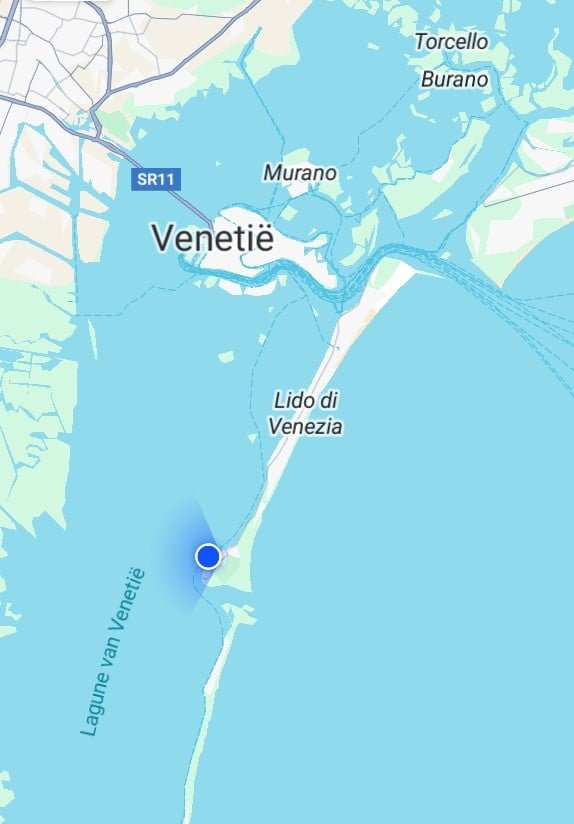
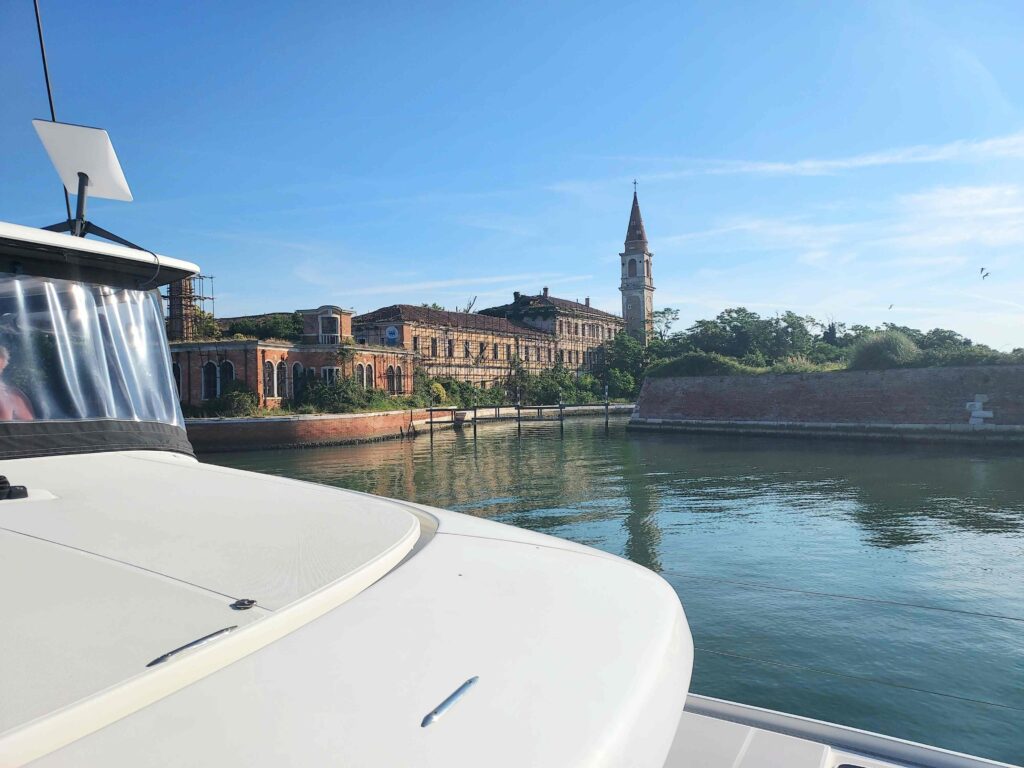
The island was already inhabited in the 9th century by refugees from Padua. Later the island was uninhabited and when the Plague broke out in Italy and the densely populated Venice was just around the corner, many sick people were sent to this island. Many died on the island (160,000) as well during several Plagues during centuries.
The island was used for a long time as a quarantine for the sick and was also nicknamed ‘Island of Ghosts’ because of the many stories about wandering souls.
There is now a beautiful fort on the island that is not allowed to be visited.
We anchored next to the island with about 10 other boats, saw a beautiful sunset and slept well on our ship.
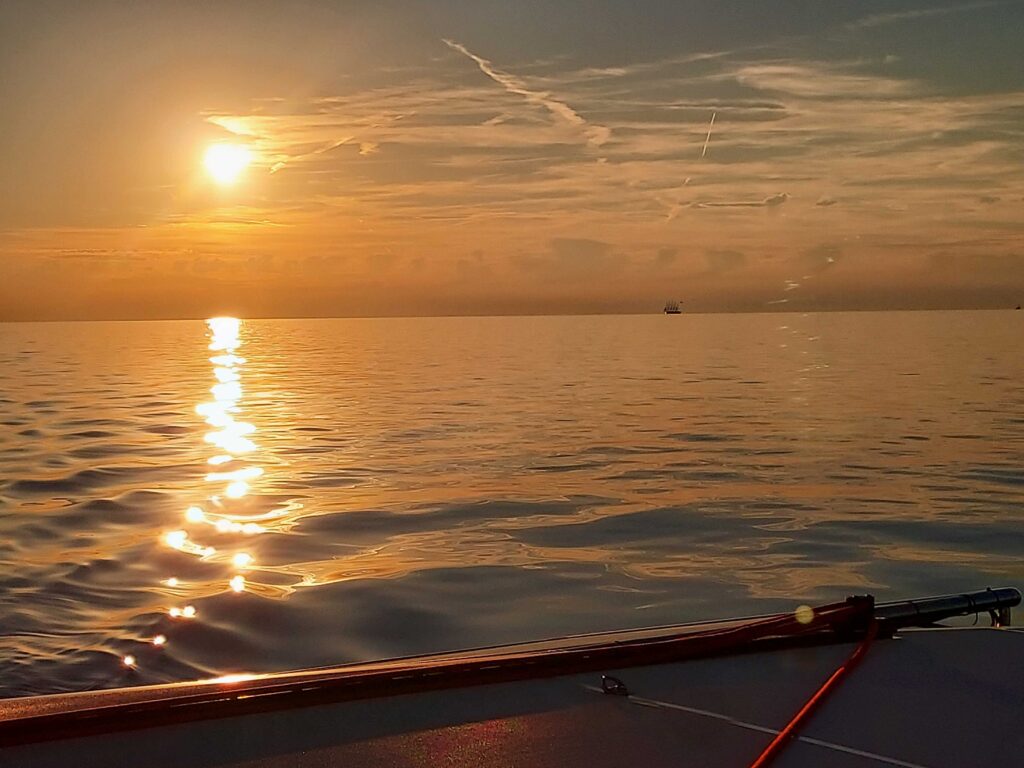
The next morning, we sailed out of the lagoon around Venice after 6 days. There was much more to see than we thought (166 islands in the end!) and with a sailboat there was ultimately a lot of freedom and ease to visit everything here. And to cycle! Because on some islands you were allowed to come with cars and bicycles.

In short, a beautiful experience richer in Venice!


